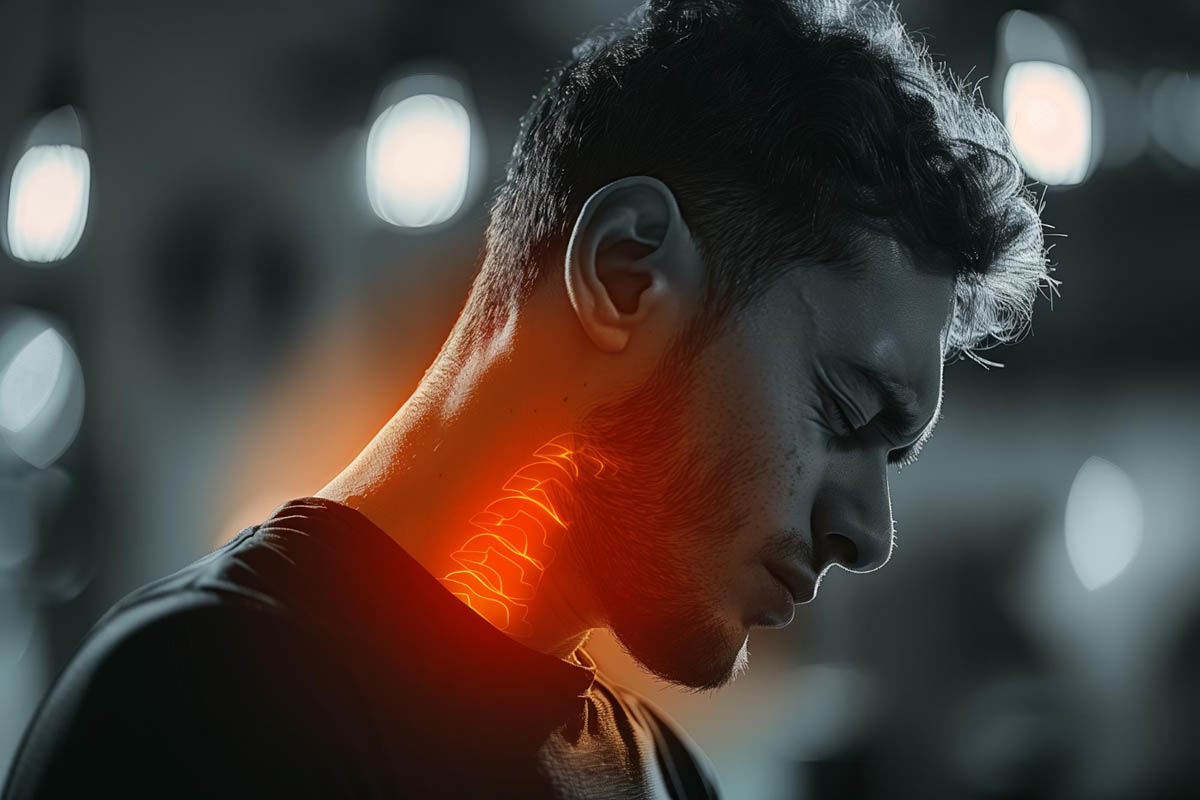The joint of the jaw, also known as the temporomandibular joint (TMJ), is a crucial structure that connects the jaw bones to the skull, allowing for the movement necessary for chewing, talking, and other essential functions. Head/neck posture, on the other hand, is something that can commonly be less than optimal, especially in today’s society with the use of smartphones, laptops, etc. When these two issues intersect, the result can be TMJ-related neck pain, a condition that affects a significant portion of the population.
Studies show that office workers with self-reported neck pain exhibit a higher prevalence of temporomandibular disorders, indicating a strong association between whiplash and these conditions. The prevalence of temporomandibular joint and muscle disorder (TMJD) is between 5% and 12%, with joint disease being a contributing factor. This blog will explore the causes, treatment, and prevention of TMJ neck pain, offering insights into how Austin Manual Therapy Associates can help you find relief, especially for disease patients with chronic conditions.
Anatomy of the Temporomandibular Joint and Neck
Understanding the connection between TMJ and neck pain begins with a basic knowledge of the anatomy involved and how TMJ can cause neck pain. The temporomandibular joint is a hinge-like structure located on each side of the head, just in front of the ears. It connects the mandible (lower jaw) to the temporal bone of the skull. This joint, along with the surrounding muscles and ligaments, allows for the movement of the jaw in various directions.
The neck, or cervical spine, consists of seven vertebrae, intervertebral discs, muscles, and nerves that support the head and enable its movement. The proximity of the TMJ to the upper cervical vertebrae means that dysfunction in one area can easily impact the other. The complex interaction between these structures often leads to the development of TMJ-related neck pain.
How TMJ Can Cause Neck Pain
The connection between TMJ dysfunction and neck pain lies in the shared muscles and nerves between the jaw and neck. The muscles responsible for jaw movement, such as the masseter and temporalis, are closely linked to the muscles in the neck, including the upper trapezius and paracervical muscles. Dysfunction in the cervical region can exacerbate pain through these shared structures, which mental disorders may also influence. When TMJ dysfunction occurs, it often leads to muscle tension and spasms that can radiate into the neck, causing jaw pain and discomfort. This tension can be measured through muscle pressure pain thresholds, which are often elevated in individuals with TMJ disorders.
Moreover, the nerves that innervate the TMJ also connect to the cervical spine, making it possible for pain to travel from the jaw to the neck. Such joint disorders often present alongside TMJ dysfunction. This is why individuals with TMJ disorders frequently report concurrent neck pain or headaches. Evidence suggests that TMJ disorders are commonly associated with other conditions of the head and neck region, including cervical spine instability and headaches. In fact, neck pain is shown to be associated with TMJ disorders 70% of the time.
Causes of TMJ and Neck Pain

Various factors can lead to the onset of TMJ and neck pain. Poor neck posture, such as slouching or maintaining a forward head position for extended periods, can put undue strain on the neck and jaw muscles, resulting in TMJ dysfunction. Emotional stress is another significant contributor, as it often triggers jaw clenching or teeth grinding (bruxism), which can overburden the TMJ and lead to neck discomfort, similar to idiopathic neck pain. Additionally, trauma to the jaw or neck—such as whiplash from a car accident—can result in TMJ dysfunction accompanied by neck pain, which can be worsened by bacterial infection. Degenerative joint conditions like osteoarthritis or the development of bone spurs may also impact both the TMJ and cervical spine, causing pain and limiting mobility, with potential opportunistic infections complicating the condition. Lastly, bad habits like chewing on chewy foods or misalignment of teeth and jaw can create extra strain on the TMJ, potentially exacerbating neck pain, especially in patients with fibromyalgia syndrome.
Symptoms and Location of TMJ Neck Pain
Can TMJ cause neck pain? TMJ-related neck pain typically presents as either a dull ache or a sharp pain that can occur on one or both sides of the neck, affecting masticatory muscle pressure pain. This discomfort may radiate from the jaw to the shoulders and upper back, contributing to Myofascial pain and associated symptoms, often accompanied by additional symptoms such as jaw tenderness, shoulder pain, headaches, clicking or popping sounds when moving the jaw, facial pain, and difficulty opening or closing the mouth. Many individuals also experience headaches, particularly concentrated in the temples or behind the eyes, along with earaches or otologic symptoms (ringing in the ears). While the specific location of the pain can differ among individuals, it usually centers around the TMJ area and the upper cervical spine.
How to Treat TMJ Neck Pain
Understanding whether TMJ causes neck pain is essential for selecting the right treatment. Treating TMJ neck pain often involves a combination of self-care practices, physical therapy, and lifestyle changes to restore normal mechanics and decrease pain associated with TMJ pain. This comprehensive approach addresses both the TMJ and cervical instability that may contribute to chronic symptoms. Here are some effective treatment options:
Gentle Exercise
Neck stretches, and jaw TMJ exercises can help alleviate tension in the muscles and improve the range of motion. Incorporating soft foods into your diet can also help minimize strain on the TMJ during this period. Your physical therapist can guide you through exercises that target both the TMJ and neck.y.
Physical Therapy
Physical therapy is a cornerstone of TMJ neck pain treatment, particularly in addressing issues such as cervical spine alignment and improving joint mechanics, and muscle tone abnormalities. A skilled therapist can help you identify and correct issues, teach you exercises to strengthen the muscles and use techniques like manual therapy to relieve pain.
Botox
In some cases, Botox injections may be recommended to reduce muscle tension in the jaw and neck. This is something that works for SOME people, but not all. Tension in the musculature is a SYMPTOM of TMJ related pain, and Botox injections can improve that symptom, but the underlying cause of that symptom still needs to be addressed.
Surgery
Surgery is typically considered a last resort for TMJ disorders that do not respond to conservative treatments. Procedures may include arthroscopy or open-joint surgery to repair the TMJ.
Prevention and Self-Care Tips to Avoid TMJ Neck Pain
Preventing TMJ neck pain involves adopting healthy habits that reduce the risk of developing this condition and exploring digital health solutions for effective management. Here are some self-care tips:
Proper Posture
Maintaining good upright posture, especially when sitting at a desk or using a computer in an upright position, can help prevent strain on the TMJ and neck. Forward head, slouching, and an inward roll of the shoulders is the most common collection of postural abnormalities in today’s society. Avoiding parafunctional habits like teeth grinding or jaw clenching is also crucial.
Jaw Exercise and Stretches
Regularly performing jaw exercises and stretches can keep the muscles around the TMJ flexible and reduce the risk of dysfunction.
Mouthguard
Wearing a mouthguard at night can prevent teeth grinding and jaw clenching, which are common causes of TMJ disorders. This can be particularly effective in patients who exhibit co-existing symptoms of TMJ and neck pain.
Reducing Stress
Managing stress through techniques like deep breathing, meditation, or yoga can help reduce the likelihood of jaw clenching and muscle tension.
When to Seek Professional Help
While self-care measures can be effective, it’s important to recognize when professional help is needed.
Signs that TMJ and Neck Pain Requires Medical Attention
If you experience persistent pain that doesn’t improve with self-care, difficulty opening or closing your mouth, or if headaches or earaches accompany your symptoms, it’s time to seek medical attention. Swelling of the swollen lymph nodes in the neck area may also indicate an underlying issue that requires professional evaluation.
Find TMJ Neck Pain Relief with Austin Manual Therapy

At Austin Manual Therapy Associates, we specialize in providing TMJ treatment Austin for TMJ-related neck pain with a comprehensive approach. Our experienced therapists will work with you to develop a personalized treatment plan that addresses the root causes of your pain. Whether you need physical therapy, posture correction, or guidance on self-care strategies, we’re here to help you find lasting relief.
Conclusion
TMJ neck pain is a complex condition that requires a multifaceted approach to treatment and prevention. By understanding the causes and symptoms and by following the right treatment plan, you can effectively manage your pain and prevent future issues. If you’re struggling with TMJ neck pain, Austin Manual Therapy Associates is here to provide the care you need.
FAQs
Can TMJ problems cause neck pain?
Yes, TMJ problems can cause neck pain due to the close relationship between the jaw and neck muscles and their shared nerve connections.
How do you get rid of TMJ neck pain?
TMJ neck pain can be managed through a combination of ice and heat therapy, gentle exercises, over-the-counter medications, and physical therapy. In some cases, Botox injections or surgery may be recommended.
How long does TMJ neck pain last?
The duration of TMJ neck pain varies depending on the severity of the condition and the effectiveness of the treatment. With proper care, many people experience relief within a few weeks to a few months.





